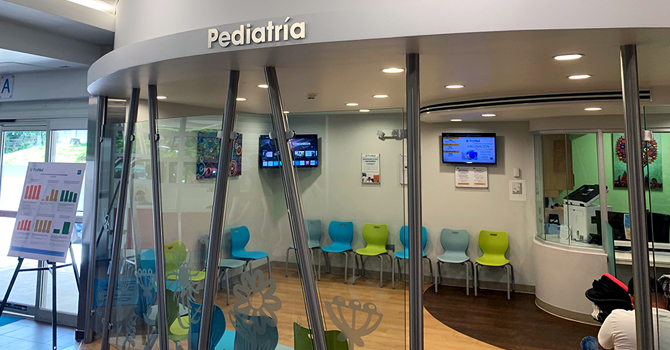Pregnancy in Puerto Rico: Protecting the Health of Women and Children by Reducing Metal Exposures

Pahriya Ashrap
PhD Student in Environmental Health Sciences
From a developmental view, children are most vulnerable during pregnancy and birth.
The body grows at tremendous speeds during these stages, so a seemingly minor amount of a toxicant can have a huge impact. And as we are learning from epigenetics—the study of heritable changes in gene expression without changes to the underlying DNA sequence—prenatal changes to a child’s biology can, years down the road, impact their offspring too.
It is essential to map the full process of pregnancy and the detrimental effects of certain chemicals to be able to develop interventions. And for every child, that starts with examining the causes of preterm birth.
Why Preterm Birth?
Preterm birth is a significant concern for public health around the world. Preterm birth occurs when a baby is delivered before the start of the 37th week of pregnancy and is the most common cause of death among infants worldwide. Survivors remain at risk for many adverse health consequences—neuro-developmental delays, disability as infants and adults, chronic respiratory problems, vision impairment, and hearing impairment.
In addition to the physical health consequences of preterm birth, the emotional and economic impact of preterm birth on families is tremendous.
Worldwide each year, an estimated 15 million babies are born too early—an average of more than 1 in 10 babies. In addition to the physical health consequences of preterm birth, the emotional and economic impact of preterm birth on families is tremendous.
Why Puerto Rico?
Studying preterm birth is especially important in a region like Puerto Rico, which has one of the highest incidences of preterm births among all US jurisdictions. Causes of preterm birth are complex and the etiology that triggers it is largely unknown, however, a number of contributing factors have been identified. Even though there is growing evidence that environmental factors may play a key role, these factors remain understudied. Many environmental exposures can be modified through technology/engineering, legislation/enforcement, and lifestyle changes, and therefore could be an optimal opportunity for prevention study.
The risk of exposure to contaminants is high for pregnant mothers in Puerto Rico.
This is also the case in Puerto Rico—environmental contamination on the island is heavy, with many hazardous waste sites and superfund sites. Superfund sites are areas contaminated by hazardous industrial waste that have been identified by the Environmental Protection Agency (EPA) as candidates for a federal clean-up program. The risk of exposure to contaminants—including but not limited to phenols and parabens, phthalates, and metals—is high for pregnant mothers in Puerto Rico. Now we have evidence, with a growing body of literature focusing on exposure to these environmental chemicals during pregnancy and the risk of preterm delivery.
Why Metals?
Metals occur naturally in the environment and enter the human body through ingestion of food and water, supplement intake, and the use of metal-containing products through inhalation and skin contact.
Metals like cadmium, mercury, and lead are non-essential to human health and toxic to the human body even in very low amounts. Metals like manganese and zinc play key roles in human physiology and are considered essential to human health—but even these can be toxic at high concentrations. Both types of metals can be environmental toxicants at high concentrations in our ecosystems.
In general, we need to learn more about metal exposures and their effect on pregnancy, especially combinations of metal exposures. Humans are continuously exposed to mixtures of environmental toxicants, and we need to study the relationship of metal exposures both individually and in combination with each other. However, studying the combined effects of any toxicant can be difficult to replicate in lab settings.
Real Risks of Metal Exposure
To bridge the gap between lab samples and what happens to human cells during daily life, we use biostatistics and other tools to study a variety of biomarkers. Lab data is clean and straightforward. Data from humans going about daily life is “messy” because we have less control over the variables. Biostatistics—applying complex math systems to biological questions—is the centerpiece of a creative critical thinking process that helps us look at chemicals we scrutinize in the lab while also incorporating human data from “real-world” contexts.
In the Puerto Rico Testsite for Exploring Contamination Threats (PROTECT) project, we collected data from 812 pregnant women to explore how environmental exposures during pregnancy may impact adverse birth outcomes such as preterm birth risk. Each woman participated in up to three study visits at approximately 18, 22, and 26 weeks of gestation. Blood samples were collected during visits and used to determine concentrations of different metals. Demographic information collected through questionnaires and birth outcome data abstracted from medical records at birth were added to improve our statistical models.
We found that pregnant women in Puerto Rico had relatively low blood-lead concentrations when compared to the general US population and to pregnant women in other countries. All blood samples in our study had lead concentrations lower than the level of concern set by the Centers for Disease Control and Prevention (CDC) for pregnant women (5 μg/dL). Despite lower concentrations, however, our analysis revealed that maternal blood lead was still more strongly associated with increased risk of preterm birth than other metals we assessed. We also found that elevated levels of the essential metals manganese and zinc during pregnancy may also adversely affect birth outcomes.
Even a Little Lead
Our results are consistent with previous studies—even low levels of lead exposure, indicated by blood lead levels well below current “safe” levels, may be associated with preterm birth. These findings provide further support for the need to reduce lead exposure as much as possible for all pregnant women. We advise pregnant women to avoid common sources of lead exposure, including lead paint in older homes, house dust, contaminated garden soil, certain cosmetics, and lead-glazed ceramics.
During pregnancy and birth, when children are so developmentally vulnerable, even slight changes in environment can impact them and even their future offspring.
For adults, a small amount of a toxicant does not always create significant health problems. For a tiny fetus, the same exposures can have detrimental effects. During pregnancy and birth, when children are so developmentally vulnerable, even slight changes in environment can impact them and even their future offspring. Sensitive periods of growth, when the body is growing rapidly and the epigenome is helping the body develop, are extremely important processes to study.
In public health, we focus on prevention. And preventing infants from getting diseases is one of the most important ways public health can protect generations of children and support their families. Improved understanding of environmental and other factors that contribute to preterm birth, together with developing sustainable technologies to remove contamination, will have direct public health impacts.
About the Author
 Pahriya Ashrap is a PhD student at the University of Michigan School of Public Health
in Environmental Health Sciences studying the impact of environmental exposures on
maternal and children's health. As part of her dissertation, she is exploring how
environmental metal exposures during pregnancy are potentially associated with preterm
birth as well as providing information on the predictors and sources of exposure among
pregnant women in Puerto Rico. She earned an MS from Harvard University T.H. Chan
School of Public Health and holds a BS from Peking University College of Urban and
Environmental Sciences.
Pahriya Ashrap is a PhD student at the University of Michigan School of Public Health
in Environmental Health Sciences studying the impact of environmental exposures on
maternal and children's health. As part of her dissertation, she is exploring how
environmental metal exposures during pregnancy are potentially associated with preterm
birth as well as providing information on the predictors and sources of exposure among
pregnant women in Puerto Rico. She earned an MS from Harvard University T.H. Chan
School of Public Health and holds a BS from Peking University College of Urban and
Environmental Sciences.
- Interested in public health? Learn more today.
- Read more articles by students, faculty, staff, and alumni of Michigan Public Health.
- Read more about Ashrap in Silk Road Native’s Dream Repeats with Every Intervention.
- Support research at Michigan Public Health.
